JOTS v35n2 - Active Learning Through Toy Design and Development
Active Learning Through Toy Design and Development
Arif Sirinterlikci, Linda Zane, and Aleea L. Sirinterlikci
Abstract
This article presents an initiative that is based on active learning pedagogy by engaging elementary and middle school students in the toy design and development field. The case study presented in this article is about student learning experiences during their participation in the TOYchallenge National Toy Design Competition. Students followed the product development process to design and realize toys. They started with marketing surveys and conception, and then followed through by making prototypes to realize these designs. The experience generated an engaging and fun learning environment that promoted higher level, divergent, and creative thought processes—an effort that is needed in today’s climate of increased attention on STEM education. Collection of two years of student work is included within this study to depict both the students’ work and their perceptions toward this work.
Active Learning through Toy Design and Development
Active Learning
Increased public attention is being paid to the education of American students within the areas of science, technology, engineering, and mathematics (STEM) ( Congressional Research Service, 2006 ). Concern is particularly heightened for K-12 education, since such students provide the foundation for rising stars in such fields. It has been reported that, when comparing K-12 students with international peers, on average American students fare more poorly on mathematics and science assessments the longer they are in school ( National Academy of Sciences, 2007 ). The stakes are high, and most Americans would agree that something must be done to energize this generation of youth—drawing them toward positive attitudes in relation to STEM fields. Active learning is one way to capture the students’ attention because it involves hands-on and collaborative methodology.
In traditional formal education, students typically learn in a didactic manner, that is, taking notes within a classroom lecture setting. Contemporary educational research indicates that such a passive environment is not effective and results in limited retention of knowledge by students ( Prince, 2004 ). Active learning is an instructional methodology that engages students in the learning process to improve the results of the process ( Bruner, 1961 ). Active learning is a multifaceted and directional approach where various interactions are welcomed (e.g., teacher-tostudent, student-to-teacher, and student-to-student) ( Grabinger & Dunlap, 2000 ).
In The Seven Principles in Action: Improving Undergraduate Education , Hatfield (1995) stated that active learning is not solely a set of learning activities, but rather it is more of an attitude-altering approach on the part of both students and faculty. According to the author, the goal is to channel the students to think about how and what they are learning, and thus having them take responsibility for their own education. As the students take a greater role in their education, self-management and self-motivation become a critical part of the learning process ( Glasgow, 1996 ; Hatfield, 1995 ).
Through active learning, knowledge is directly experienced, constructed, acted upon, tested, or revised by the learner ( Holzer, 1994 ). Active learning’s critical components include using multiple senses and doing; problem defining, generating, and solving; interacting within and outside teams; high-level thinking; and relieving stress. Active learning involves using multiple senses (e.g., hearing, seeing, and feeling), interacting with other people and materials, and responding to or solving a problem. Students engaged in successful active learning tasks within team environments develop good communication skills, higher-level thinking skills, an emphasis on teamwork, a positive attitude toward the subject, and motivation to learn. Such benefits result from a team’s perseverance, whereby teams continue to tackle problems that individuals often abandon. A team that includes fellow students also generates an environment with less pressure and fear of failure ( Grabinger & Dunlap, 2000 ).
Other academic sources agree with the critical importance of problem solving, but ask students to be engaged in higher order thinking tasks as analysis, synthesis, and evaluation, especially at higher levels of education. According to Silberman (1996) , the students should do most of the work. They need to study ideas, solve problems, and apply what they learn. Learning should be fast-paced, fun, supportive, and engaging. Hearing something, seeing it, questioning it, and discussing it with others allow students to learn the subject matter more thoroughly. Students need to manipulate their learning, figure things out by themselves, come up with examples, try out skills, and complete assignments that depend on the information they either have acquired or should acquire.
Problem-based, experiential, and inquiry-based learning are the most often cited forms of active learning ( Kirschner, Sweller, & Clark, 2006 ). Similar concepts (such as discovery learning and cooperative learning), whereby students work in teams on problem solving under project management structures, lead to self-confident students who feel accountable and become team members ( Grabinger & Dunlap, 2000 ). It does not matter what the methodology or at which level it is applied, it should address at least one or more of the following concepts:
- Dialogue with Self . This concerns a learner thinking reflectively about a topic of interest or work. Students write about what they learn, how they learn it, and the role this knowledge plays in their own life, and perhaps how they feel. Tools used to facilitate such reflective thinking may include journals and learning portfolios.
- Dialogue with Others . This is more than listening to an instructor, which is one-way interaction. A more active form of dialogue occurs when teachers create small-group discussions on a topic. They also can involve students in dialogue situations with practitioners or experts either inside or outside of class. Additional activities can include “pair-shares,” and collaborative learning groups, such as teams, student debates, and student-led review sessions.
- Observing . This occurs whenever a student either watches or listens to another person doing something related to the subject being studied. This might be observing a teacher, listening to musicians, or observing natural, social, or cultural phenomena.
- Doing . This refers to any learning activity in which the learner actually does something: writing a research proposal and conducting the research, completing a project (e.g., designing and developing an engineering structure), critiquing an argument or piece of writing, and making an oral presentation. Analyzing case studies and role-playing in simulation activities also can be employed, but these indirectly engage students in the doing process.
Adopting an active learning methodology does not necessarily require the replacement of highly structured teaching methods or eliminate the lecture format. Kirschner, Sweller, and Clark (2006) suggested that 50 years of empirical data do not support using active learning very early in the learning process. They suggest that formal and structured methods are needed early to establish a strong basis or background within any given area, and this then can be strengthened by the active learning activities.
The following case study was used to investigate the relationship between active learning and the “TOYchallenge” National Competition. The authors questioned whether involvement in the competition increased the student participants’ levels of interest in and understanding of scientific inquiry and engineering-related processes. The next section provides background information on the initiative and the TOYchallenge competition.
TOYchallenge National Competition.
In the fall of 2005, Robert Morris University (RMU), located in suburban Pittsburgh, PA, and its neighbor Moon Area Elementary School Challenge (Gifted) Program started a unique means of collaboration. Elementary school students from two local elementary schools were transported to RMU every Monday at noon, to work for two hours on their projects. These students were introduced to the TOYchallenge National Toy Design Competition at RMU; they were given the challenge to design and develop toys or games as entries to the competition. At the time, the burgeoning competition was sponsored by the Sigma Xi International Science Honor Society, Southwest Airlines, and Hasbro Toy Company, and it was organized by Sally Ride Science.
The TOYchallenge, for student teams from grades 5-8, offered them the chance to design and develop toys and games ( Sally Ride Science, n.d. ). Teams were coached by an adult who was 18 or older. A team could include 3 to 6 members. In order to encourage greater levels of scientific inquiry and interest in STEM careers among young women, at least 50% of the group members were girls. Each person could belong to only one team, and each team could submit only one design. The young developers submitted their original design ideas in a proposal form, which served as the preliminary elimination round. Each team was allowed $150 during the initial development process that led to the preliminary round. Any items purchased or donated had to be included within the total cost figure.Teams kept an itemized expenditure list, including signed receipts, and submitted it with their preliminary entries. Teams that qualified for the national round were expected to build the working prototype of their designs within a $200 budget constraint. If a team did not spend the initial $150, it could roll over that money toward purchases during the final preparations stage. An additional $50 could be used in preparation for the final presentation in excess of the $200. The following rules were enforced to maintain originality of design: (a) Any toy or game that has previously been recognized with a prize in a competition including TOYchallenge cannot be reentered, (b) The toy or game cannot include parts from existing commercial toys or games, (c) A team can only choose one category within which to work.
Categories for the 2006 and 2007 competitions included (Sally Ride Science, n.d.):
- Get Out and Play: a category that promoted outdoor activities.
- Games for the Family: an exciting game designed for the whole family to enjoy.
- Toys that Teach: the competitors designed toys that can be used in teaching people of all ages.
The TOYchallenge organization saw this competition “as a chance for teams of imaginative kids to create a new toy or game. Toys are a great way to learn about science, engineering, and the design process” ( Sally Ride Science, n.d. ). The following design steps were presented by the competition organization on the competition web page:
- Determining the definition of the toy/game, the category, and its objective
- Conducting research to gather more information about the possible designs
- Brainstorming
- Picking a design idea from alternatives
- Planning by recording in the logbook what you are trying to do and how you will get it done
- Preparing working drawings for prototyping
- Preparing the preliminary entry
- Prototyping to realize the design idea chosen
The most recent TOYchallenge web sources include a brief reference on the engineering design process, which is slightly different and improved as compared to the original one ( Sally Ride Science, n.d. ). The current site includes the following steps (a) Brainstorming, (b) Research, (c) Developing ideas, (d) Creating a drawing for the preliminary and prototype for finals, (e) Testing and Evaluation, (f) Communication, (g) Redesign. This engineering design process replicates the process of scientific inquiry, which should be encouraged in K-12 classrooms.
The preliminary entry report was limited to 6 pages. It is similar to an engineering design proposal and includes the following content:
-
Section 1: Your Toy or Game (no more than _ page)
- What category did you choose?
- What is the name of your creation?
- What is the object of your toy/game?
- Who is the target market for your toy/game, and why?
-
Section 2: How Does it Work? (no more than _ page)
- Explain how your toy/game works. Be specific.
-
Section 3: Your Team (no more than _ page)
- Where are you from?
- How did you work together to develop your idea?
- How did you divide up the responsibilities and complete your creation?
- Section 4: Your Design Process (no more than 2 pages)
- Section 5: Photos/Sketches of Your Toy/Game (no more than 2 pages)
- Section 6: Preliminary Round Entry Budget (no more than 1 page)
Development process . At the first meeting, students were given the necessary forms; also the lead author gave a presentation on the competition. Mini-lessons would be followed by complementary workshops on an as-needed basis. The students also were directed to develop their games or toys based on the product development methodology in a creative and imaginative way. After studying the various categories of competition, students briefly discussed the categories of interest. However, they did not select their final categories until the results of their Marketing Survey (in which they surveyed their relatives and friends) were compiled. Based on the results of these surveys, they chose their game categories. In the process, they collected the following data from the survey participants:
- Age of the participant
- Gender of the participant
- Type of TOYchallenge category the participant likes the most
- Most favorite toy/game that the participant own/owned
After the determination of the category – Toys that Teach – student groups (a large group was associated with each elementary school) conducted layered brainstorming activities ( Birch & Clegg, 2000 ). Students were given 2 minutes to think about the topic and then read their answers to the group; as the process was repeated, they were encouraged to consider others’ ideas and to combine these ideas. The students discussed alternative concepts through brainstorming, and then they voted for the “best” design. The original design ideas included each student’s (within the respective group) vision of the design (a sketch) and its object (problem statement). The object included the details of the designs. Students were presented the concept of constraints . Thus, students were told that some of the design components may not be realized within the physical, temporal, and financial restraints of the project, which helped them to refine their concepts.
Two entries were submitted to the 2006 TOYchallenge Competition. One group submitted a board game called “ 3D Animal Rescue .” The other group submitted a music-based board game entitled “ MUSIC MANIA ,” which could double as two separate games. During the decision-making process for both groups, gender played a major role. This was evident when the girls in the 3D Animal Rescue group wanted to submit a game that included less action but more learning, while the boys focused on male-favored activities. Because the teams contained more girls, most of their ideas were chosen.

After the preliminary round, the 3D Animal Rescue board game qualified for the East Coast Nationals, which was held at Sigma Xi Headquarters in Raleigh, North Carolina. In order to prepare for the national competition, the team followed the product development process. Students studied the details of their proposal and finalized the rules for their game. They also made solid models of the game pieces and models of animals to be included as a part of the 3D design scheme (Figure 1). The students used both AutoCAD and Mastercam software tools in making the solid models. However, Mastercam was used as the main program because it can be used in simple and effective ways to generate STL (Stereolithography) files. Parts were built in the RMU Rapid Prototyping (RP) Laboratory under the supervision of the lead author. Students painted the game pieces after they were built by the SLA (Stereolithography) RP machine. Figure 2 shows group members painting the game pieces. Students also decided to use a wooden game box that coupled as a game board. These two components were built by the students under supervision of the lead author. The construction process is illustrated in Figure 3. The group completed the game cards and game board at one of the final meeting sessions. In addition to the CAD and RP components, students built basic electrical circuits to realize one of their most creative ideas—turning the lights on at the winning player’s animal hospital (Figure 4). As the winning player rescued the last required animal, he or she pushed the hospital into a slot that illuminated the lights at the hospital. The completed game board is shown in Figure 5.
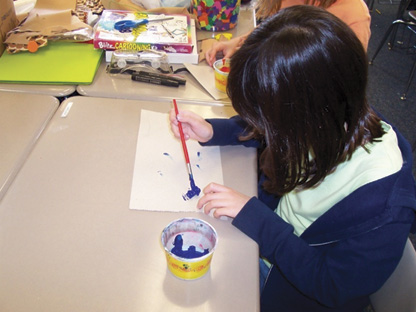
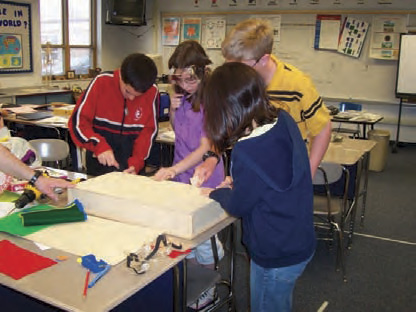
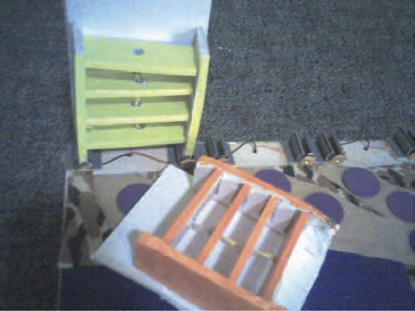
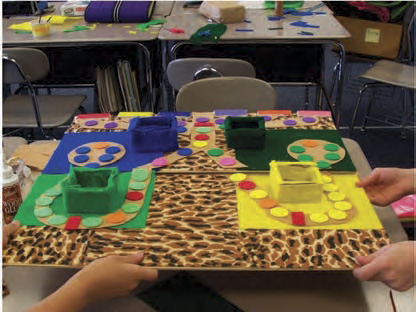
At the 2006 East National Finals, two group members gave a successful presentation, even though the group did not earn any awards. The items required for the final presentation consisted of the project budget, the logbook, team members’ t-shirts, and a presentation board.
The 2007 project was conducted as an after-hours activity at the lead and third author’s residence due to other gifted activities occupying students’ school schedules. The second year’s qualifying project was a life-sized board game that could be played outdoors. It was named “ PALM ISLAND ,” and it included coconuts, makeshift purses, a giant palm tree, and the board. Similar to the process followed in the first year’s competition, after the students completed the development process, these students and their friends tested the game to make sure it worked and was ready to use (Figure 6).
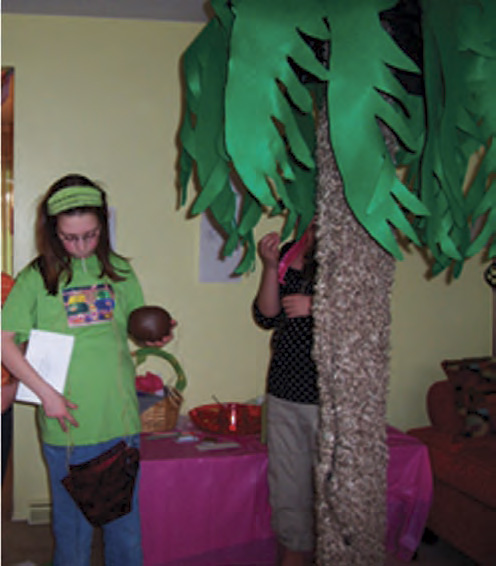
Student responses . As mentioned previously, in the second year the initiative became an after-hours activity held outside the RMU Engineering Department, even though the lead author was still involved. Thus, the team also had limited access to both the engineering laboratories and the equipment.
After the successful completion of the projects and presenting them at the 2007 Nationals, students answered surveys about the experience. The surveys were based on the original surveys developed by the TOYchallenge organization. These questions tried to gauge the students’ perceptions of the engineering field (as a result of the toy design and development process mirroring the engineering product design and development process). These questions were designed to learn if time spent engaged in active learning and toy development dispelled any myths or preconceived notions regarding STEM careers, engineering in particular. The first survey section contained the following questions:
- Engineers probably have interesting stories to share about their work.
- Engineering is boring.
- It would be fun to be an engineer.
- I think I will take engineering classes in college.
- I might pursue a career in engineering.
- Engineers usually work alone on projects.
- Most people my age think engineering is cool.
Maximum point value of each response was 7 points, representing “Strongly Agree,” whereas 1 point represented “Strongly Disagree.” Most students indicated that they were neutral toward the engineering discipline. This could be a result of less exposure to engineering tools or the group being an all-girls’ team.
To the contrary, the students moderately disagreed with engineering as being boring. This could reflect a somewhat positive attitude toward the engineering process, even if the students did not anticipate entering into the field as an adult. The results of the survey section are displayed in Figure 7.

A second set of questions focused on the development process and students’ attitudes toward active learning. This set of questions was intended to be more global, and to ascertain the students’ holistic attitudes toward the process of toy development and design. It was surmised that although students’ singular involvement in the process might not push them into a STEM career, being actively involved in the process of inquiry might promote initial positive feelings toward foundational scientific procedures. Introductory positive feelings and levels of comfort with scientific processes, utilizing active learning methodology, is the first step toward students becoming scientifically literate.
Better results were obtained from the second set of questions. The maximum point value for each of the following three questions was 5. A score of 1 indicated “Strongly Disagree,” and a score of 5 indicated “Strongly Agree.” As one can see in Figure 8, the students’ level of comfort in using technology and building things was extremely high, and their comfort with the engineering design process was average.
- Comfortable using technology
- Comfortable using the engineering design process
- Comfortable building things
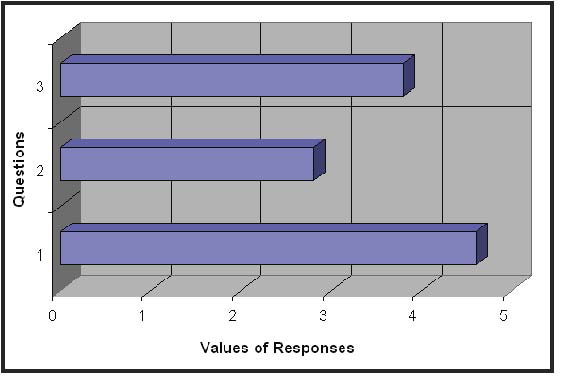
Conclusions
At a time when many educators are considering ways to strengthen America’s scientific and technological foundations, it is imperative that students be given numerous and varied experiences within STEM fields ( National Academy of Sciences, 2007 ). This focus is evident, starting with a mandate from the Oval Office in November 2009. President Obama, in an effort to focus more attention on scientific inquiry and technological innovation in the United States, launched the Educate to Innovate campaign—an effort to make STEM education a priority for the next decade ( The White House, 2009 ).
Although STEM education is facing a resurgence in popularity, school districts remain bound by the standards set forth by the No Child Left Behind Act of 2001 (NCLB). In an effort to increase students’ reading and mathematics scores, NCLB legislation has pushed science to the sidelines, often leaving such instruction to the discretion of the classroom teacher. Many students are lacking in the types of scientific experiences that will inspire future leaders in STEM fields ( Marx & Harris, 2006 ). If national leaders truly believe in motivating and encouraging the next generation of leaders in scientific and technological fields, identifying educational approaches that promote collaborative scientific inquiry is essential.
Active learning represents an effective method of dynamically engaging students in the learning process, and it promotes scientific inquiry in an authentic manner. This case study, detailing the processes involved in the TOYchallenge competition, exemplified the benefits of active learning, that is, gaining hands-on experience in engineering design and development, especially regarding the product design and development process. The products used in these cases were toys and games, items that the students can relate to.
After guiding the students through the TOYchallenge competition for two consecutive years, it became evident to the authors that the hands-on learning required by the competition was a highly effective means of promoting the scientific method with young learners. In addition, some of the student survey responses reflected positive attitudes toward the engineering process, albeit their lack of interest in pursuing the field as an adult. Survey responses also showed positive attitudes toward students’ comfort levels with utilizing technology and building things. Although it is not possible to ascertain whether TOYchallenge experiences actually caused these attitudes, observations by the instructors provided anecdotal evidence that students enjoyed the process. The active learning process also was interactive and collaborative, as evidenced by student-to-teacher, teacher-to-student, and most important, student-to-student interactions. By using cooperative learning, students were able to assume different roles, communicate their thoughts, work collaboratively on projects, and negotiate to settle differences. The team environment, with an enjoyable project at its core, also induced less pressure and fear of failure. It became evident that the knowledge-construction process was enhanced by the high level of collaboration and communication ( Edelson, Pea, & Gomez, 1995 ). Scientific endeavors rely on the collaborative process, and the students benefited from seeing this in action ( Edelson, 1998 ).
The students took charge of their projects, and self-management and self-motivation played a critical role for most of the students. This is similar to the problem-based learning process, as promoted by Duffy and Cunningham (1996) . According to Duffy and Cunningham, the problem-based model best exemplifies a constructivist method of learning, whereby students manage their own learning in order to solve authentic, real-life problems. True learning occurs when students are provided authentic problems, and they encouraged to be both collaborative and self-directed in order to find creative solutions, under the guidance of a facilitator who provides the necessary resources. Such learning was evident throughout the two years of involvement with the TOYchallenge competition.
The active learning experiences also promoted scientific inquiry by heightening the students’ observation skills. The students heard, saw, spoke, wrote (in logbooks), drew (sketches), and questioned during the development process. They explored a set of ideas, and used high-level thinking in making decisions and solving problems, replicating the process of scientific inquiry used by experts in STEM fields. The students also benefited from being able to apply what they learned throughout the product development process--from the initial marketing survey, to ideation, and finally to the realization of the working prototype stages. By moving sequentially through each phase of the process, the students not only gained valuable experiences in marketing, product development, and execution, but they also witnessed the practicality of scientific pursuits. By applying knowledge to real-world problems and settings, the students were able to experience the benefits of an authentic learning experience—learning that is concrete and useful ( Edelson, 1998 ).
At the conclusion of their active learning experience, the students successfully exchanged ideas with themselves and others, were self-reflective and self-directed in their learning, enhanced their powers of observation, and brought their ideas to fruition via an excellent product. They accomplished what engineers and product designers do in their professional lives—realization of a successful and useful product. In addition, the students were immersed in the process and its steps, both technical and not technical. They had to understand and enact budget constraints, project management principles, and the implications of their designs on production.
Due to the heightened awareness of STEM education among the nation’s students, the evidence put forth for active learning within science education is compelling. Building a strong foundation for students in science education will (we hope) encourage students to pursue careers in STEM fields, thereby returning the competitive advantage of the United States within the areas of science and technology. The aforementioned processes of active learning could be extremely beneficial to science educators because they promote scientific thought and attitudes in an engaging and authentic manner.
This case study reflects a group of students who demonstrated two essential attitudes that are characteristic of scientists—uncertainty and commitment ( Edelson, 1998 ). They forged through the uncertainty by collectively brainstorming solutions to problems, by discovering the needs of the public through marketing surveys, and by collaboratively agreeing upon solutions to their problems. Each step of the process required the second essential characteristic—commitment. The students were self-directed learners, who followed through with each discovery to realize its final outcome.
Such experiences promote scientific inquiry and knowledge construction in a way that no textbook or lecture could; an active learning methodology is challenging, engaging, and enlightening. It is our belief that all students would benefit from exposure to scientific inquiry through an active learning model, and it is our hope that future STEM education includes the resources and training to promote authentic, hands-on learning within all K-12 classrooms.
Dr. Arif Sirinterlikci is an Associate Professor of Engineering and Director of Engineering Laboratories at Robert Morris University School of Engineering, Mathematics, and Science, Moon Township, Pennsylvania. He is a Member-at-large of Epsilon Pi Tau.
Dr. Linda Zane is an Assistant Professor of Early Childhood Education at Slippery Rock University, Pennsylvania.
Mrs. Aleea L. Sirinterlikci is a Masters student in Instructional Leadership at Robert Morris University School of Education and Social Sciences, Moon Township, Pennsylvania.
References
Birch, P., & Clegg, B. (2000). Imagination engineering: A toolkit for business creativity . New York: Prentice Hall.
Bruner, J. S. (1961). The act of discovery. Harvard Educational Review, 31 , 21-32.
Congressional Research Service. (2006). Science, technology, engineering, and mathematics (STEM) education issues and legislative options . Washington, DC: The Library of Congress.
Duffy, T. M., & Cunningham, D. J. (1996). Constructivism: Implications for the design and delivery of instruction. In D. H. Jonassen (Ed.), Handbook of research for educational communications and technology (pp. 170-198). New York: Simon & Schuster Macmillan.
Edelson, D. C. (1998). Realising authentic science learning through the adaptation of scientific practice. In K. Tobin & B. Fraser (Eds.), International handbook of science education (pp. 317-331). Dordrecht, Netherlands: Kluwer Academic.
Edelson, D. C., Pea, R. D., & Gomez, L. (1995). Constructivism in the collaboratory. In B. G. Wilson (Ed.), Constructivist learning environments: Case studies in instructional design . Englewood Cliffs, NJ: Educational Technology Publications.
Glasgow, N. A. (1996). Doing science: Innovative curriculum for the life sciences . Thousand Oaks, CA: Corwin Press.
Grabinger, R. S., & Dunlap, J. C. (2000). Rich environments for active learning: A definition. In D. Squires, G. Conole, & G. Jacobs (Eds.), The changing face of learning technology (pp. 8-38). Cardiff: University of Wales Press.
Hatfield, S. R. (1995). The seven principles in action: Improving undergraduate education . Bolton, MA: Anker Publishing Company.
Holzer, S. M. (1994, Spring). From constructivism to active learning. The Innovator, 2 . Retrieved March 5, 2009, from http://www.succeednow.org/innovators/innovator_2/innovator002.html .
Kirschner, P. A., Sweller, J., & Clark, R. E. (2006). Why minimal guidance during instruction does not work: An analysis of the failure of constructivist, discovery, problem-based, experiential, and inquiry-based teaching. Educational Psychologist 41 (2), 75-86.
Marx, R. W., & Harris, C. J. (2006). No Child Left Behind and science education: Opportunities, challenges, and risks. The Elementary School Journal 106 (5), 467-477.
National Academy of Sciences. (2007). Rising above the gathering storm: Energizing and employing America for a brighter economic future . Washington, DC: National Academies Press.
Prince, M. (2004). Does active learning work? A review of the research. Journal of Engineering Education, 93 (3), 223-231. Retrieved October 13, 2008 from http://www4.ncsu.edu/unity/lockers/users/f/felder/public/Papers/Prince_AL.pdf .
Sally Ride Science. (n.d.). Toy Challenge . Retrieved June 12, 2007 from http://www.sallyridescience.com/toychallenge/.
Silberman, M. (1996). Active learning: 101 strategies to teach any subject . Des Moines, IA: Prentice-Hall.
The White House. (2009). President Obama launches “Educate to Innovate” campaign for excellence in science, technology, engineering, and math (STEM) education . Retrieved January 5, 2010 from http://www.whitehouse.gov/the-press-office/president-obama-launches-educate-innovate-campaignexcellence-science-technology-en .